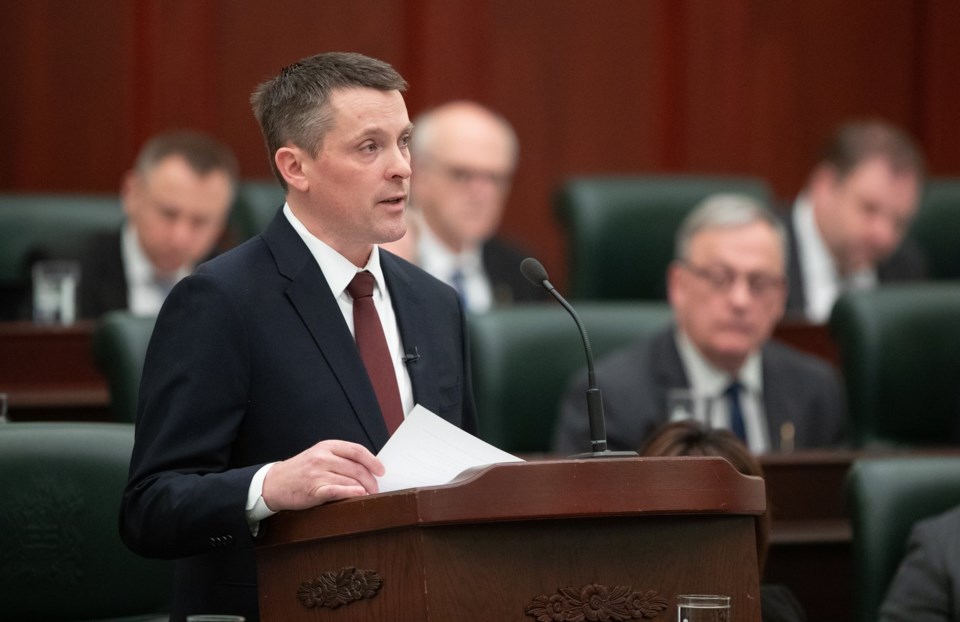EDMONTON — Alberta is forecasting a $4.6-billion surplus for this fiscal year, but Finance Minister Nate Horner says "mounting pressures" threaten to soon put the province in the red.
Horner made the comments Thursday as he delivered the new numbers in the second-quarter update to this year’s budget.
Aside from Alberta’s traditional reliance on volatile oil revenues, Horner said there are other worries, such as a promise by incoming U.S. president Donald Trump to impose punishing trade tariffs.
"We don't forecast potential future policy, but we certainly monitor it," Horner said.
Trump, who will be sworn into the top job in January, has promised to impose 10 per cent tariffs on all U.S. imports. Nearly all of Canada's crude oil exports went south of the border last year, and the Canadian Chamber of Commerce estimates the tariffs would take a $30-billion bite out of Canada's economy.
Some oil market researchers have predicted that Canadian oil would be excluded from the tariff, but Horner noted "it's hard to do math on rhetoric."
"I think obviously we're very tied to the price of oil."
A key Alberta budget barometer is the price of the oil benchmark West Texas Intermediate.
Horner noted the WTI price has been toggling above and below the US$70-per-barrel mark for a while, with every US$1 drop in that price taking $630 million out of Alberta’s coffers.
The government had recently expected WTI to average US$76.50 a barrel this year, but is now revising that expectation down.
Horner said the government needs to get at least US$68 per barrel for the rest of the fiscal year, which ends in March, to reach the forecast surplus.
If oil prices stay below US$70, he said future deficits are "very likely.”
But Horner said even a deficit wouldn't rule out the UCP implementing its long-promised $1-billion personal income tax cut.
"We are very committed to the tax cut,” he said.
"The premier's gave me every indication she would like to see it sooner rather than later."
The tax cut was Premier Danielle Smith’s Day 1 campaign promise en route to her United Conservatives winning a majority government in the 2023 election.
Smith promised tax changes to deliver an extra $760 a year for everyone making over $60,000 at a cost of about $1 billion to the treasury.
NDP Leader Naheed Nenshi wouldn't say if he supports the promised tax cut but said any government deficit is just "deferred taxation."
"It means your kids and your grandkids have to pay the taxes with interest, so let's see if this government can balance the budget."
The $4.6-billion projected surplus is far higher than the $367-million surplus projected when Horner introduced the budget earlier this year.
But $2.9 billion of that surplus is expected to be cash, which would be split between paying down debt and contributing to Alberta’s long-term nest egg Heritage Savings Trust Fund.
The value of that rainy day fund has grown to $24.3 billion from $23.4 billion since the first-quarter update in August, Horner said.
The government says the surplus is largely the result of higher-than-expected income tax revenue thanks to Alberta's sharp population growth and oil and gas royalties.
On the downside, Horner said much of the government's $2-billion contingency fund — used for unexpected mid-year expenses — has already been used up.
About $850 million of the contingency spending went to responding to emergencies and disasters, such as the wildfire that destroyed one-third of the tourist town of Jasper in July.
Horner said other money went to help health care and schools to try and keep up with Alberta's population growth, which was 4.4 per cent — or about 207,000 people — between July 2023 and July of this year.
Alberta's population growth is expected to drop significantly next year, reaching just 2.5 per cent, mainly as a result of reduced federal immigration targets.
Despite slower population growth, the government is forecasting Alberta's unemployment rate will grow to an average of 7.4 per cent in 2025 from an average of 7.2 per cent seen so far in 2024.
This report by The Canadian Press was first published Nov. 21, 2024.
Jack Farrell, The Canadian Press




